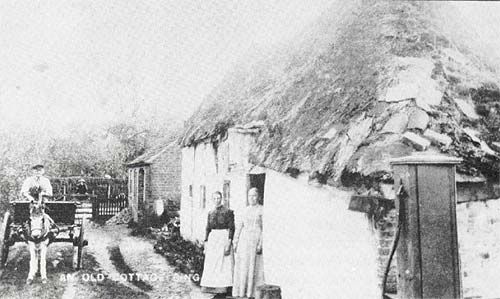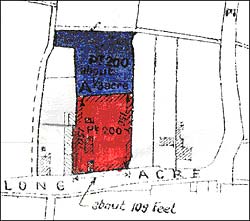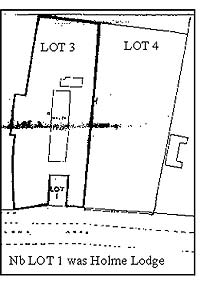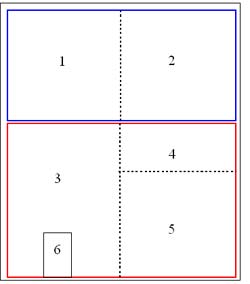Donkey Green's Cottage
23 Long Acre East
Known for a time as White Croft
Known as one of the oldest houses in Bingham, Donkey Green's Cottage was part of the Shelford Estate of the Earls of Chesterfield, passing by marriage to the Earls of Carnarvon towards the end of the nineteenth century. The Estate passed to the crown in lieu of estate duty in 1925 following the death in 1923 of the 5th Earl. He had spent most of his fortune on excavating the tomb of Tutankhamen.
As with other properties formerly owned by the Estate,
the paperwork does not commence until the first sale from the Estate,
in this case in 1931.
Donkey Green’s Cottage is one of three houses for which a professional
house history report has been prepared. This found that the original part
of the house is typical of many small buildings built before 1750. One
of the internal timbers, a post supporting a remaining cross-beam, has
been dated by dendrochronology to probably somewhere between 1570-1590.
Whilst this sample alone cannot convincingly date the building, the building
is of a type that existed then. Although now called a cottage it could
then have been used by a small farmer or tradesman. Probably originally
built solely of timber studs and mud infill its main walling was refaced
and in places fully replaced by brick in the 18th century. Click here
to see more (link to new home page oldest houses).
The centre part of the cottage is generally reckoned by building historians to be seventeenth century. The cottage is not a listed building. The name 'Donkey Green' is believed to derive from a tenant of the 1860s named Robert Green. He used to travel the villages selling his garden produce from a cart drawn by his donkey, hence 'Donkey Green'. One appears in Whites 1864 directory as a cottager in Long Acre. Three generations can be tracked in the censuses. In 1841 one was aged 65, in 1881 another was 65 and in 1891 there was a 39 year old Robert - probably the one in the photograph which was taken about that time. He was a widow and lived with his 76 year-old mother Frances, sister Martha (37) and daughter aged 16. And in the 1881 census aged 65 and a widower. A schedule dated 1921 in the bundle of deeds for 21 Long Acre East mentions one neighbour as being Robert Green, grandson of the original Robert Green. Perhaps the sale of 1931 followed his demise. Typically cottagers were small-scale farmers with anything from a couple of acres to fifty.

This postcard, dated about 1904, was made from
an original photograph taken in 1890
The photograph shows Robert Green with his mother, sister and daughter (the one on the gate). The outbuilding is now the garage. Unlike the cottage it is tiled not thatched. The door to the outbuilding is clearly visible; today one can make out the join in the brick infill. The outbuilding would presumably have been for the donkey, or the cart or for storage or for some combination. The cottage appears to have a window on the first floor (just above the lady's head) which is not present today. In the interior passage to the left of the present front door there are two overhead beams which were possibly at ceiling height then and now have about 18 inches of clear space to the ceiling. The height of these beams would have given sufficient room for a bedroom in the roof space. The dilapidated outbuilding in the foreground has been rebuilt as a modern services extension and a lounge was added in recent time on the western side of the cottage.
 The Crown Commissioners sold the cottage to
Leonard Saxon Braithwaite, a plumber of Woodborough Road, Nottingham,
on July 14th 1931. This presumably followed the death of whoever was
the tenant at the time, as the Crown rarely sold to sitting tenants,
but seemed to sell as soon as the tenant they had inherited died or
left. The area of land was 1800 square yards and the price £75.
Interestingly, at that time the address was Long Acre, no 'East'.
As with other former properties on the Estate the Earl had reserved
the mineral rights.
The Crown Commissioners sold the cottage to
Leonard Saxon Braithwaite, a plumber of Woodborough Road, Nottingham,
on July 14th 1931. This presumably followed the death of whoever was
the tenant at the time, as the Crown rarely sold to sitting tenants,
but seemed to sell as soon as the tenant they had inherited died or
left. The area of land was 1800 square yards and the price £75.
Interestingly, at that time the address was Long Acre, no 'East'.
As with other former properties on the Estate the Earl had reserved
the mineral rights.
The abstract of title prepared when Braithwaite registered the property in 1934 shows him living still at the Woodborough Road address so presumably he let the cottage, or maybe used it as a second home? A resident of Bingham remembers the cottage being derelict although she is not sure of the date.
On 1 July 1942 Braithwaite sold to Marjorie Noble of Gunthorpe Hall, Lowdham for £550. She did live in the cottage. On 5 October 1944 Miss Noble sold to Violet Catherine Pratt-Barlow of Holme Lodge, opposite, for £1250. This is where the recent history of ownership gets interesting. As far as we know although both Holme Lodge and the cottage were owned by the Estate they were not 'of a piece' although it is always possible that the eighteenth century tenants of the cottage were employed by the Estate.
Miss Pratt-Barlow continued to live at Holme Lodge, so again we can only speculate as to why she bought it, what use she made of it and what relationship if any she had with any tenant. At Holme Lodge, Miss Pratt-Barlow was a tenant of the Crown commissioners. On 13 January 1951 Miss Pratt-Barlow died at Holme Lodge.
In May 1951 Lady Phyllis McCraith bought Donkey Green's Cottage for £1260 from Miss Pratt-Barlow's executors but never seemed to have lived there. This purchase is recorded in the supplemental abstract of title in the Holme Lodge deeds, 1955, but is not present in the bundle of deeds for the cottage. In July the Crown sold Holme Lodge for £1100 to her husband, Sir Douglas McCraith, a Nottingham solicitor who lived at Normanton Grange, Plumtree. Lady Phyllis lived at Holme Lodge, and local folklore has it that Sir Douglas remained at Normanton Grange. She was said to have been keen on horse racing and her jockey is thought to have lived over the stables in the barn on the corner of Dark Lane. Maybe he used Donkey Green's Cottage.
 Sir Douglas died on 16 September 1952. In August
1955 his executors, one of whom was Lady Phyllis, sold Holme Lodge
and Donkey Green's Cottage to Henry Perry Griffin of Old Mill House,
Lowdham, company director. He was a director of the Nottingham department
store Griffin and Spalding, later to become Debenhams. He paid £7500
for a total of 2.73 acres. He then moved to live at Holme Lodge.
Sir Douglas died on 16 September 1952. In August
1955 his executors, one of whom was Lady Phyllis, sold Holme Lodge
and Donkey Green's Cottage to Henry Perry Griffin of Old Mill House,
Lowdham, company director. He was a director of the Nottingham department
store Griffin and Spalding, later to become Debenhams. He paid £7500
for a total of 2.73 acres. He then moved to live at Holme Lodge.
On 31 December 1964 Griffin sold the land to the rear of Holme Lodge and Donkey Green's Cottage to Hericon developments. He sold Holme Lodge and the garage to Donkey Green's Cottage to John Raymond Sail, of 14 Market Place Bingham, as sub purchaser. This sale included the garage of Donkey Green's Cottage. In a similar fashion Donkey Green's Cottage was sold as lot 3, measuring 931 sq yards to Mr and Mrs Roy Taylor as sub purchasers, although for some reason he sold first to Hericon for £1500 and in the same transaction they sold on to the Taylors for £2000. The Taylors took out a mortgage with Bingham RDC. Thus the original (1931) Donkey Green's Cottage plot was divided in three, presumably to increase the whole site's development value, and Lot 4 was to have been sold to a Mr Fred Garner (see below).
The Taylors sold to Mr and Mrs Meres for £15000 in 1956 and the present owner acquired the property in 1988. The garage of Donkey Green's Cottage was sold to the present owner of the cottage in 1988.
INFILL
The development of Bingham from the 1750 has been a story of continual infill of original farmland and cottagers' closes, just like Robert Green's. It is interesting to trace the subsequent division of the original Donkey Green's Cottage land, i.e. the red and the blue plots on the first plan. The whole plot stretched back a far as the track leading from Cogley lane to Manor Close. The diagram below shows how it was subdivided and built upon at various stages.
 The whole diagram represents the property as
it probably was for Robert Green.3,4,5 (red outline) is the plot
sold by the Crown to
The whole diagram represents the property as
it probably was for Robert Green.3,4,5 (red outline) is the plot
sold by the Crown to
Braithwaite in 1931 and then by Griffin to Hericon in 1964.
3 was sold as the cottage plot by Hericon in 1964.
6 is the garage, sold to Holme Lodge by Hericon in 1964 and sold back to the cottage in 1988.
1 and 2 (blue outline) were rented by Braithwaite from the Crown and sold by the Crown in 1964 to Garner to build 7 and 9 Cogley Lane respectively.
4 and 5 were sold by Hericon to Garner in 1964 (lot 4).
5 was sold by Garner in 1973 to build number 25 Long Acre East.
Braithwaite bought only the part marked in red. The blue portion was reserved by the Commissioners, together with the right of access for them and their successors in title along the western boundary for repairs. They appear to have agreed to lease him the blue area. (This is recorded on an abstract of title for Braithwaite with the deeds for Holme Lodge).
When he sold in 1942 the access covenant continued but mention of the lease of the blue land did not. One supposes that this plot was recovered by the Crown and sold as part of the separate development to the rear of Donkey Green Cottage.
The two plots together measure about two thirds of an acre - would this have been about enough land for Robert Green's market garden? Or might he have rented more land from the Earl?
A detailed history of this house can be read by clicking here.
